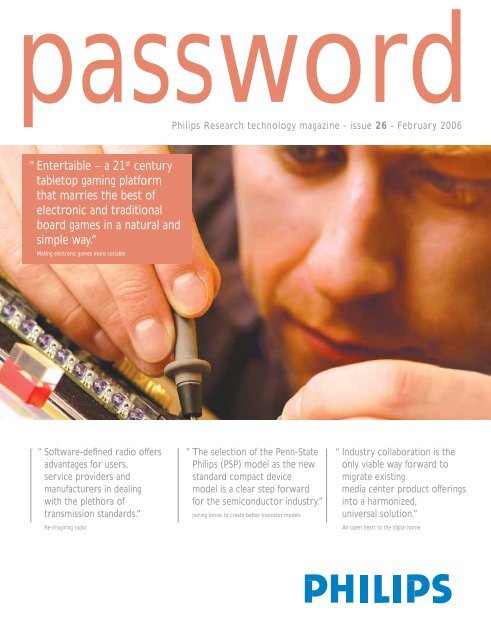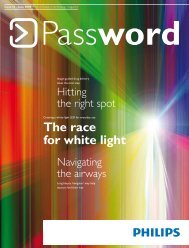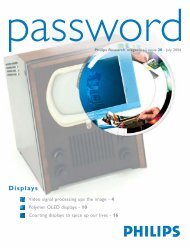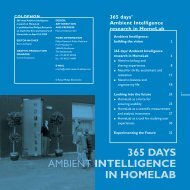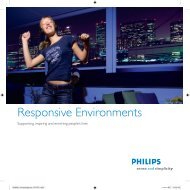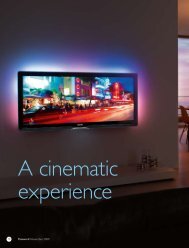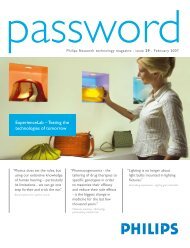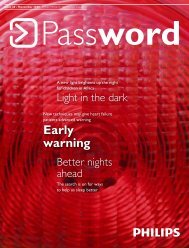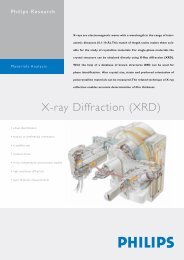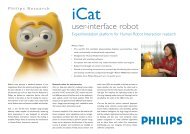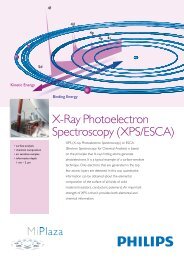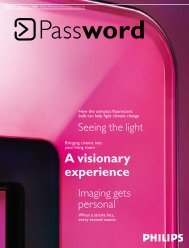article - Philips Research
article - Philips Research
article - Philips Research
You also want an ePaper? Increase the reach of your titles
YUMPU automatically turns print PDFs into web optimized ePapers that Google loves.
password<br />
<strong>Philips</strong> <strong>Research</strong> technology magazine - issue 26 - February 2006<br />
“ Entertaible – a 21 st century<br />
tabletop gaming platform<br />
that marries the best of<br />
electronic and traditional<br />
board games in a natural and<br />
simple way.”<br />
Making electronic games more sociable<br />
“ Software-defi ned radio offers<br />
advantages for users,<br />
service providers and<br />
manufacturers in dealing<br />
with the plethora of<br />
transmission standards.”<br />
Re-imagining radio<br />
“ The selection of the Penn-State<br />
<strong>Philips</strong> (PSP) model as the new<br />
standard compact device<br />
model is a clear step forward<br />
for the semiconductor industry.”<br />
Joining forces to create better transistor models<br />
“ Industry collaboration is the<br />
only viable way forward to<br />
migrate existing<br />
media center product offerings<br />
into a harmonized,<br />
universal solution.”<br />
An open heart to the digital home
Main <strong>article</strong><br />
An open heart to the digital home<br />
Media centers represent the convergence of PCs and<br />
consumer electronics (CE) products such as DVDs, settop<br />
boxes and MP3 players into a single ‘digital hub’. While<br />
the leading current generation of media centers is exciting<br />
and offers universal compatibility, keeping them that way is<br />
going to be an enormous challenge – even for the largest<br />
companies. Therefore, <strong>Philips</strong> proposes an ‘Open Media<br />
Center’ platform.<br />
Password is a quarterly magazine<br />
published by <strong>Philips</strong> <strong>Research</strong>.<br />
<strong>Philips</strong> <strong>Research</strong>, part of Royal <strong>Philips</strong><br />
Electronics, has fi ve main laboratories<br />
in three continents where 2100<br />
researchers investigate promising<br />
options for innovation.<br />
Editor-in-chief<br />
Peter van den Hurk<br />
E-mail:<br />
peter.j.van.den.hurk@philips.com<br />
Production management<br />
Claudia van Roosmalen<br />
Erica Schrijvers<br />
6<br />
Distribution management<br />
Cees Jan Mol<br />
Erica Schrijvers<br />
Editorial Board<br />
Prof. Dr Emile Aarts, the Netherlands<br />
Dr Tobias Helbig, United Kingdom<br />
Dr Peter Wierenga, the Netherlands<br />
Dr Thomas Zängel, Germany<br />
Ellen de Vries, the Netherlands<br />
Dr Satyen Mukherjee, USA<br />
Design and Art Direction<br />
Storm Scott, Eindhoven<br />
6<br />
Printer & Lithography<br />
Roto Smeets Services, Eindhoven<br />
In this issue Editorial<br />
Main <strong>article</strong><br />
6 An open heart to the digital home<br />
Features<br />
16 Technology<br />
Re-imagining radio<br />
24 Lifestyle<br />
Entertaible – Making electronic games more sociable<br />
Further in this issue<br />
4 What’s new<br />
12 Another perspective<br />
Joining forces to create better transistor models<br />
14 Technology news<br />
20 Joint contribution<br />
Expanding boundaries - Creating a world of seamless<br />
connectivity<br />
Other contributors to this issue<br />
William Third<br />
More information<br />
and subscription<br />
<strong>Philips</strong> <strong>Research</strong> Public Relations Dept<br />
Prof. Holstlaan 4<br />
5656 AA Eindhoven, the Netherlands<br />
Tel. +31-40-27 43403<br />
Fax +31-40-27 44947<br />
E-mail:<br />
prpass@natlab.research.philips.com<br />
See also<br />
www.research.philips.com<br />
© KONINKLIJKE PHILIPS<br />
ELECTRONICS N.V. 2006<br />
All rights reserved<br />
Articles may be reproduced in whole<br />
or in part provided that the source<br />
‘<strong>Philips</strong> <strong>Research</strong> Password’ is<br />
mentioned in full; photographs and<br />
illustrations for this purpose are<br />
available via the above-mentioned<br />
website. The editor would appreciate a<br />
complimentary copy.<br />
As Bob Dylan so famously sang “For the times, they are a-changin’”,<br />
and that was 42 years ago. There has been no let up since.<br />
Change is continuous and it is now taking place at an even<br />
faster pace than we could have ever imagined. Change, and making<br />
choices has become an integral part of our everyday lives,<br />
all the time, everywhere.<br />
“ Change, and making choices has become<br />
an integral part of our everyday lives, all<br />
the time, everywhere. ”<br />
For example, the increasing number of coexisting, competing and<br />
evolving standards in mobile communications can sometimes make<br />
life more complex rather than easier – which choice should you<br />
make? New approaches in an apparently mature area such as radio<br />
communications lead the way towards greater simplicity: with<br />
software-defi ned radio technologies, using a combination of<br />
software and controllable hardware to cover multiple standards,<br />
we are still fi nding new ways of making mobile communication<br />
easier to use.<br />
At home, consumers currently often face a number of choices<br />
when attempting to organize their collection of digital content<br />
– photos, songs, videos - and accessing an ever-expanding number<br />
of digital media channels. Innovative home media centers seem to<br />
Continuous<br />
change is a<br />
way of living<br />
be the answer for now, but even with these, a growing number of<br />
standards will make it diffi cult to keep fi nding the right, simple<br />
solutions in the future. Industry collaboration is a viable way<br />
forward to migrate existing product offerings into harmonized,<br />
universal solutions.<br />
On January 5th, 2006, at the Consumer Electronics Show (CES),<br />
we showed a prototype of ‘Entertaible’, a new vision on electronic<br />
gaming. It is a tabletop gaming platform that marries traditional<br />
multi-player board and computer games in a uniquely simple and<br />
intuitive way, allowing players to engage in a new class of more<br />
sociable electronic games. This is true change and innovation - to<br />
take two ‘older’ concepts, and combine them into something<br />
completely new that may alter your perception of a table forever.<br />
In December last year, the joint PSP (Penn-State <strong>Philips</strong>)<br />
transistor model was chosen by the CMC (Compact Model<br />
Council) as the industry-wide standard for future nanometer chip<br />
design. This again shows that continuously thinking and acting<br />
beyond our own boundaries and choosing best-in-class partners in<br />
a spirit of Open Innovation really moves us forward.<br />
Rick Harwig,<br />
CEO <strong>Philips</strong> <strong>Research</strong><br />
2 <strong>Philips</strong> <strong>Research</strong> Password 26 l February 2006 <strong>Philips</strong> <strong>Research</strong> Password 26 3<br />
l February 2006
Double-layer LCD technology<br />
brings clarity to radiology images<br />
Scientists at <strong>Philips</strong> <strong>Research</strong> have developed an<br />
advanced double-layer LCD technology that<br />
drastically enhances the clarity and detail visible in<br />
radiology images. This technology offers patients<br />
the prospect of earlier, faster and more reliable<br />
diagnosis, improved treatment and a better<br />
prognosis. The benefi ts are expected to be<br />
particularly signifi cant in the diagnosis of diseases<br />
such as cancer (particularly breast cancer)<br />
and arteriosclerosis.<br />
Based on two LCD screens sandwiched together<br />
with intermediate polarizers and an enhanced<br />
backlighting system, <strong>Philips</strong> high-contrast dual-layer<br />
More information: www.research.philips.com/newscenter/archive/2005/051129-lcd.html<br />
LCD technology dramatically increases the<br />
displayable grey-scale range, and allows almost<br />
100% blocking of the backlight to achieve a much<br />
better black level. Coupled with the high-intensity<br />
backlighting already fi tted to FIMI <strong>Philips</strong><br />
medical-grade LCD displays, the result is a<br />
high-brightness, high-contrast display that maintains<br />
a high contrast ratio even when viewed at<br />
a very wide viewing angle. <strong>Philips</strong> <strong>Research</strong>’s<br />
demonstrator for the technology is a<br />
1.3-megapixel (1280 x 1024) 18.1-inch DICOM<br />
compatible grey-scale display with 750-cd/m2 peak<br />
brightness, 0.005-cd/m2 black level and a contrast<br />
ratio in excess of 100,000:1.<br />
New techniques for faster<br />
molecular-imaging applications<br />
<strong>Philips</strong> is currently developing fast quantitative<br />
Magnetic Resonance (MR) acquisition and<br />
data-analysis techniques for molecular-imaging<br />
applications. Evaluation of the new techniques in<br />
collaboration with luminary clinical sites, such as<br />
the University Hospital Münster, Germany, the<br />
National Institutes of Health (NIH) in Bethesda,<br />
More information: www.research.philips.com/newscenter/archive/2005/051129-mri.html<br />
What’s new What’s new<br />
USA, and the Washington University in St. Louis,<br />
USA, has shown that quantitative MRI is indeed a<br />
powerful tool for the early assessment of diseases<br />
and for monitoring the effects of therapy in<br />
follow-up studies. Moreover, by non-invasive<br />
measurements of drug effects, quantitative MRI can<br />
speed up the development and approval of drugs.<br />
Examination of an X-ray image on a<br />
high-brightness, high-contrast LCD prototype<br />
Quantitative measurement of contrast agent<br />
concentration in Magnetic Resonance Imaging<br />
(MRI)<br />
Heart modeling system speeds up<br />
cardiac care<br />
New powerful image analysis and modeling<br />
software from <strong>Philips</strong> <strong>Research</strong> to reveal detailed<br />
heart function will save cardiologists a great deal<br />
of time and effort in extracting the information<br />
they need for the accurate diagnosis of heart<br />
disorders. As a result, patients will benefi t from<br />
faster and more reliable test results, more effective<br />
and personalized therapies and speedier recovery.<br />
Using advanced image analysis techniques<br />
combined with detailed clinical knowledge about<br />
the structure and function of the human heart,<br />
scientists at <strong>Philips</strong> <strong>Research</strong> have developed an<br />
innovative cardiac modeling system that extracts<br />
a large number of morphological and physiological<br />
measurements from multi-slice CT (computed<br />
tomography) images. In more than 90% of the<br />
cases it does so entirely automatically, saving<br />
cardiologists a great deal of costly time and effort.<br />
Although <strong>Philips</strong> has used cardiac CT as an initial<br />
application and proof of concept, <strong>Philips</strong> believes<br />
that this new modeling technology will be<br />
applicable in other areas of radiology and other<br />
imaging modalities as well.<br />
More information: www.research.philips.com/newscenter/archive/2005/051129-heartmod.html<br />
<strong>Philips</strong> introduces new Blu-ray Disc<br />
products and media at CES 2006<br />
On January 4th , 2006, <strong>Philips</strong> Electronics<br />
announced the introduction of a Blu-ray Disc<br />
consumer electronic player (BDP 9000), an all-inone<br />
PC Writer (TripleWriter) and new Blu-ray<br />
media (BD-R and B-RE, single-layer 25 GB and<br />
dual-layer BD-R and BD-RE 50 GB) at the 2006<br />
Consumer Electronics Show (CES).<br />
Both the BDP9000 consumer player and the<br />
TripleWriter (SPD7000) will be available in the<br />
second half of 2006.<br />
More information: www.ces.philips.com/downloads/Blu-ray_Release.doc<br />
<strong>Philips</strong>’ new Blu-ray solutions offer consumers the<br />
ultimate storage platform for high-defi nition (HD)<br />
entertainment and digital archiving, providing consumers<br />
the ability to store massive amounts of content<br />
on a single disc. Additionally, Blu-ray Disc is the<br />
next-generation platform for HD playback of video<br />
content and is supported by more than 160 of the<br />
world’s largest gaming manufacturers, movie studios,<br />
consumer electronics and PC manufacturers.<br />
<strong>Philips</strong> researchers working with <strong>Philips</strong>’ new<br />
cardiac modeling software that automatically<br />
matches its heart model to the patient’s<br />
multi-slice CT scan, and then creates a highly<br />
detailed patient-specifi c 3D model from<br />
which a wide range of morphological and<br />
physiological measurements can be extracted.<br />
4 <strong>Philips</strong> <strong>Research</strong> Password 26 l February 2006 <strong>Philips</strong> <strong>Research</strong> Password 26 5<br />
l February 2006
An open heart to<br />
the digital home<br />
Not a week seems to go by without yet another ‘media center’ product being launched that claims<br />
to be qualifi ed to become the ‘center of our digital lives’. Media centers represent the convergence<br />
of PCs and consumer electronics (CE) products such as DVDs, set-top boxes and MP3 players into a<br />
single ‘digital hub’. However, there is a cloud on the horizon. While the leading current generation of<br />
products, such as the <strong>Philips</strong> Showline Media Center (MCP9350i), is exciting and offers universal com-<br />
patibility, keeping them that way is going to be an enormous challenge – even for the largest<br />
companies. Therefore, <strong>Philips</strong> proposes an ‘Open Media Center’ platform based on a shared<br />
development (and thus distributed cost) open middleware model. A universal model that would<br />
ultimately allow participating companies to gradually migrate – yet still fully differentiate –<br />
their existing standalone products through proprietary, plug-in applications.<br />
By Andrew Woolls-King and Steven Keeping<br />
Illustrations/photography: <strong>Philips</strong>, Storm Scott<br />
Main <strong>article</strong> media centers<br />
Right now, the personal computing (PC) and consumer electronics (CE) worlds are engaged<br />
in an epic race that promises to transform electronic home entertainment for hundreds of<br />
millions of consumers. The potential prize for the winner is to sell the products that deliver<br />
all manner of digital content to the home for the next several decades. But it could be a prize<br />
beyond the reach of any single company.<br />
The phrase ‘media center’ essentially refers to a centralized, on-line digital hub – compatible<br />
with any number of portable data and media storage devices – feeding content to a user<br />
interface front-end. This content – such as video and audio – is transported through the home<br />
via a high-speed, hard-wired (e.g. Ethernet) or wireless network. While the concept might<br />
sound attractive, transforming it into a compelling product for everyone from grandparents to<br />
teenagers is a daunting challenge.<br />
Simplicity and convenience are critical. If the success of the original <strong>Philips</strong> Compact Disc and<br />
today’s digital MP3 players and music libraries have taught us one thing: users love products<br />
that give them simple, convenient and customizable access to their content via a delivering<br />
mechanism that, frankly, just makes sense. Equally critical is the ability to handle any existing<br />
or future content streams and formats. The current list includes high-defi nition TV, Internet,<br />
Main <strong>article</strong> media centers<br />
digital (including Internet) radio, MP3 music, audio and podcast downloads, pictures, home<br />
videos and games.<br />
Notable product examples to date include the <strong>Philips</strong> MCP9350 iMedia Center introduced at<br />
IFA 2005. This delivers TV, Internet, music, video, photos and more to any room in the home.<br />
In another example of innovative product development, <strong>Philips</strong> has released a wireless music<br />
center, dubbed the WACS700, which enables consumers to store their entire CD collection on<br />
a 40-GB hard disk and listen to it in any room via wireless streaming. Yes – it’s only for music<br />
at present, but it represents a very realistic vision of the media center concept in action.<br />
“ The harsh market reality is that in the world of<br />
the 21 st century digital consumer, the content is king.”<br />
Eric Kaashoek, <strong>Philips</strong> Comsumer Electronics<br />
While both these products lead the way when it comes to contemporary media center<br />
functionality – including the use of advanced, easy-to-use interfaces – nobody is claiming they<br />
are yet genuinely universal solutions. But a comprehensive solution that is compatible with<br />
absolutely anything the end user could throw at it, is what tomorrow’s consumer will both<br />
demand and expect of their media centers.<br />
<strong>Philips</strong> <strong>Research</strong>, <strong>Philips</strong> Consumer Electronics and <strong>Philips</strong> Semiconductors are rising to the<br />
challenge by developing the roadmap for next-generation media centers. Exactly what these<br />
second or possibly even third-generation devices will be like is still to be decided. What’s<br />
certain is that the hardware, middleware and software will need to handle a proliferation of<br />
digital media and deliver it to the consumer, quickly, conveniently and to the highest quality.<br />
Frank van Tuijl (<strong>Philips</strong> <strong>Research</strong>) showing a prototype<br />
of an Open Media Center.<br />
6 <strong>Philips</strong> <strong>Research</strong> Password 26 l February 2006 <strong>Philips</strong> <strong>Research</strong> Password 26 7<br />
l February 2006
WACS700 music center<br />
Main <strong>article</strong> media centers Main <strong>article</strong> media centers<br />
“The harsh market reality is that in the world of the 21st century digital consumer, the content<br />
is king,” says Erik Kaashoek, responsible at <strong>Philips</strong> Consumer Electronics (CE) for<br />
migrating <strong>Philips</strong> <strong>Research</strong> projects into viable commercial products for CE. “Therefore any<br />
future consumer media center product – if it is to enjoy universal success – needs to put the<br />
needs of the consumer and their desire to intuitively access and organize this digital content<br />
fi rst, and allow the implementation to follow second. Mass-market consumers simply<br />
won’t buy into tomorrow’s media centers if they don’t continue to make their lives<br />
dramatically easier and can accommodate every form of digital media and content<br />
without introducing complexity.”<br />
Together we can achieve more<br />
“The problem is that the engineering and fi nancial resources required to sustain media center<br />
innovation at its current rate is growing exponentially,” notes Frank van Tuijl, R&D project<br />
leader for media centers with <strong>Philips</strong> <strong>Research</strong>.<br />
In fact, it is a massive challenge, even for companies the size of <strong>Philips</strong>, and not without a<br />
huge element of risk. Yet it doesn’t have to be this way. By working together, CE companies<br />
could distribute the technological development and fi nancial burden and achieve far more<br />
for the consumer.<br />
“Recent evolutions of many traditional PC and consumer electronics products are beginning<br />
to encroach on each other’s territories,” illustrates van Tuijl. “Both the games console and PC<br />
products offer video and music playback, and hard drive set-top boxes provide secure on-line<br />
MCP9350i media center<br />
shopping, pay-per-view video and TV programming. And there are even hard drive-based<br />
audiovisual products that include PC operating systems with digital hub-like multi-room<br />
interface capabilities.”<br />
“However, all these products have evolved along separate paths to deliver certain specifi c<br />
functionality supremely well, and have then been adapted – almost as an afterthought,” explains<br />
van Tuijl. “This inevitably compromises the product for attempting to do more than was<br />
originally intended by conventional re-use or re-cycling of established software and standards.”<br />
“That’s not to say there’s anything wrong with software re-cycling and sharing – it’s<br />
commercially vital and actually what the Open Media Center aims to conserve and promote.<br />
But it’s at the multiple – rather than single – PC/CE vendor scale that we’ll see the whole<br />
market migrating in a new direction and developing new software better suited to the universal<br />
media center ideal.”<br />
Indeed, that the current products have successfully evolved from previous products is<br />
testament to the pragmatism and design skill of the PC and CE manufacturers. But it also<br />
suggests that no one is willing to risk developing a bespoke universal media center solution<br />
alone – it’s just too expensive.<br />
“It would demand tens to hundreds of millions of Euros in R&D investment – particularly on<br />
the software side,” says van Tuijl. “And individual companies would have to master unfamiliar<br />
technology if they hoped to create a media center that was truly all things to all users.<br />
Even a company the size of <strong>Philips</strong> cannot be an expert in all the required disciplines.”<br />
Towards an Open Media Center approach<br />
Frank van Tuijl’s research team has already spent several years of exhaustive investigation<br />
within <strong>Philips</strong> <strong>Research</strong> into media centers. “We realize we will fi nd it very challenging to<br />
develop universal next-generation media centers on our own,” van Tuijl says. “Yet media<br />
centers are an enormous part of the future of consumer electronics that simply cannot be<br />
ignored. Industry collaboration is the only viable way forward to migrate existing product<br />
offerings into a harmonized, universal solution.”<br />
This is how the <strong>Philips</strong> ‘Open Media Center’ idea was born. “It’s a concept centered around a<br />
strategic, industry-wide collaboration involving an open source type of approach that we want<br />
to openly propose to the world’s consumer electronics companies,” explains Erik Kaashoek.<br />
“It’s a completely new paradigm. One built from the ground up to meet the needs of the end<br />
application and that – who knows – could one day be extended to encompass a thriving open<br />
source community as well?”<br />
But it’s early days yet for the Open Media Center. “It’s a vision with no predetermined<br />
architecture or technology road maps,” says Kaashoek, “but a vision that we believe is of<br />
paramount importance to the CE sector. It will encourage the strategic migration of the best<br />
features of each area of the industry into a new common, unifi ed framework for the future.”<br />
The operating system for an Open Media Center (OMC) product would also likely be based on<br />
a non-proprietary OS such as Linux, with the joint development middleware in the center, and<br />
major proprietary application plug-ins on top that could possibly be extended to include opensource<br />
products as well (perhaps like shareware and freeware software in the PC world sits<br />
The ‘mythical’<br />
set-top box<br />
At the recent Consumer Electronics<br />
Show (CES) in Las Vegas, <strong>Philips</strong><br />
demonstrated a tablet TV front-end<br />
wirelessly streaming SDTV<br />
(Standard-Defi nition TV) digital video<br />
from a so-called ‘MythTV‘ hub using the<br />
latest state-of-the-art, low-power <strong>Philips</strong><br />
Semiconductor technology. A second TV<br />
front-end has also been developed that<br />
receives HDTV (High-Defi nition TV)<br />
streams from the same hub over<br />
Ethernet and displays them on a HDTV.<br />
Nexperia is the <strong>Philips</strong> brand for a unique<br />
group of products that streamline<br />
development of next-generation,<br />
connected multimedia appliances.<br />
MythTV is a General Public License<br />
(GPL) based, but proprietary ’plug-in‘<br />
software product that allows developers<br />
to create an experimental ’home media<br />
convergence box‘ using open-source<br />
software and operating systems.<br />
“MythTV’s capabilities include pause,<br />
fast-forward and rewind of live TV;<br />
installation of multiple video capture<br />
cards to record more than one program<br />
at a time to different hard disks, and<br />
support of multiple front-end clients<br />
each with a common view of all<br />
available programs,” explains Eric<br />
Persoon of <strong>Philips</strong> Advanced<br />
Semiconductors Laboratories. “The<br />
software also includes other useful<br />
functionality such as a picture-viewing<br />
application, a DVD viewer and a music<br />
playing application that supports MP3.”<br />
The CES application was based on the<br />
Nexperia STB810 semiconductor system<br />
solution. This combines the <strong>Philips</strong><br />
PNX8550 home entertainment engine, a<br />
Linux operating system and all required<br />
AV codecs. The result is a unit that<br />
can provide video telephony, time-shift<br />
recording, DVD playback, personal video<br />
recording, network connectivity and<br />
Voice-over-IP.<br />
8 <strong>Philips</strong> <strong>Research</strong> Password 26 l February 2006 <strong>Philips</strong> <strong>Research</strong> Password 26 9<br />
l February 2006
OMC reference<br />
architecture<br />
Application<br />
Plugin<br />
Application<br />
Plugin<br />
OMC framework<br />
OMC Middleware API<br />
Communication<br />
...<br />
Database<br />
Media player<br />
Graphics<br />
Application<br />
Plugin<br />
AV API + OS API<br />
AV Streaming Linux OS<br />
Audio<br />
Figure 1<br />
Overlay<br />
Video<br />
Storage<br />
Network<br />
CPU<br />
OMC Application Plug-ins<br />
OMC framework<br />
Required Support Libraries<br />
AV Streaming Platform<br />
Basic OS Functionality<br />
Open source and proprietary software in harmony<br />
An example of where <strong>Philips</strong> has incorporated its proprietary software<br />
alongside open-source middleware (in this case Linux) is its Active Block<br />
I/O Scheduling System (ABISS). This technology – which essentially enables<br />
real-time hard disk access at low power for reliable data intensive streaming<br />
(e.g. high-density video) – will be critical to ensure a media center can provide<br />
seamless broadcast capabilities. Particularly when asked to<br />
multi-task due to access requests made by other applications and users<br />
during operation.<br />
The ABISS system architecture is shown in fi gure 2. A set of modifi cations<br />
to the Linux kernel provides the basic ABISS framework. The scheduler itself<br />
can be implemented as a Loadable Kernel Module, which interfaces with the<br />
framework using the standard Linux module interface. <strong>Philips</strong> wanted to<br />
allow any application to use the ABISS functionality and allow third parties<br />
to provide proprietary schedulers with the ABISS framework, while protecting<br />
the IPR in its own scheduler.<br />
Main <strong>article</strong> media centers Main <strong>article</strong> media centers<br />
alongside major applications from established vendors), as illustrated in fi gure 1 on the left.<br />
<strong>Philips</strong> already has a number of proof-of-concept applications where proprietary solutions run<br />
on open-source software such as Linux in a commercially protected product. Examples are the<br />
Linux OS-based Nexperia STB810 system solution (see box ‘The ‘mythical set-top box’) and<br />
the ABISS system architecture (see box ‘Open source and proprietary software in harmony’.<br />
Both products adapt low-cost, open-source Linux software from the PC world to fi t the needs<br />
of the CE space without sacrifi cing intellectual-property right (IPR) protection. Such an ‘open<br />
source’ and CE alignment could prove invaluable to the development of a true media center,<br />
whether a Linux or proprietary OS was used.<br />
The global aim would be to produce a single, modular, standard platform that really does offer<br />
the best of all worlds (which will be crucial to consumer acceptance). This would be able to<br />
support each individual company’s proprietary solutions as almost ‘plug-in’ type products that<br />
will have gradually migrated over time from their standalone contemporary cousins.<br />
For its part, <strong>Philips</strong> has already developed some illustrative plug-in software applications<br />
designed to customize the output of a media center (whether existing or in the future) to suit<br />
an individual’s precise needs. (See box “Your personal Clint Eastwood Channel”.)<br />
Protecting IPR<br />
Despite the optimism, turning the Open Media Center vision into a reality in the fi ercely<br />
competitive world of consumer electronics won’t be easy or risk-free. There will be enormous<br />
competitive constraints; chief among which is how CE fi rms will protect their intellectualproperty<br />
rights (IPR) within such a vast and far-reaching, essentially software-based program.<br />
“One way an Open Media Center could approach this is by breaking down the application into<br />
a common middleware platform upon which customized and IPR protected proprietary plug-in<br />
applications can be supported,” explains Arnoud Engelfriet, a patent attorney and IPR specialist<br />
within <strong>Philips</strong> Intellectual Property and Standards (IP&S).<br />
Application Library Daemon<br />
Linux<br />
kernel ABISS<br />
Scheduler<br />
Policy 1<br />
Policy 2<br />
Figure 2<br />
“What format the common middleware – i.e. joint development software stack – would take,<br />
would have to be carefully considered. That said, the joint development model would in my<br />
opinion be entirely capable of supporting a robust IPR protection mechanism for the plug-ins,”<br />
Engelfriet adds. “The challenge would be ensuring that this IPR plug-in mechanism maintained<br />
a properly secure distance between the open and proprietary components, but did not inhibit<br />
their ability to freely communicate with the middleware during operation.”<br />
“ Industry collaboration is the only viable way forward to migrate<br />
existing product offerings into a harmonized, universal solution. ”<br />
Frank van Tuijl, <strong>Philips</strong> <strong>Research</strong>,<br />
Chasing the big prize<br />
In the longer term, <strong>Philips</strong> believes the Open Media Center vision is a viable way for the CE<br />
market to meet market expectations for what next-generation, universal media center<br />
solutions could and should be. While it does not intend to aggressively thrust the concept on<br />
the world’s major CE vendors, it does intend to begin tentative discussions and to highlight why<br />
it would be the best solution for CE.<br />
“According to our research, 80 percent of the profi ts from a next-generation open media<br />
center product would come from the plug-ins,” says van Tuijl. “This means companies could<br />
concentrate their product differentiation efforts there, while minimizing commercial risk on the<br />
middleware by collaborating. There would be absolutely no competitive advantage for any fi rm<br />
to develop the middleware on its own.”<br />
“This means the Open Media Center concept is about as perfect a win-win for CE companies<br />
and consumers as can be expected in the real world,” summarizes Kaashoek. “It will create the<br />
kind of competition that will drive the on-going development of continually improving and new<br />
innovative applications, but at the same time give consumers enormous choice and value. This<br />
means the CE fi rms get access to what could be the largest consumer electronics market the<br />
world has ever seen, at a migratory pace that is technically achievable and commercially low<br />
risk, and in a way that will give consumers ever widening access to products that exactly meet<br />
their needs at a price level they can afford. That is what the <strong>Philips</strong> Open Media Center vision<br />
is all about.”<br />
Frank van Tuijl l <strong>Philips</strong> <strong>Research</strong> l frank.van.tuijl@philips.com<br />
Extra info www.research.philips.com/password l media centers l open invention network<br />
Your personal ‘Clint<br />
Eastwood’ channel<br />
Imagine how compelling it would be<br />
for Clint Eastwood fans if their media<br />
center could scan the channels for<br />
Clint’s fi lms and collate them into a<br />
special ‘Clint Eastwood Channel’.<br />
With the <strong>Philips</strong> Flexchannels plug-in<br />
– designed to run on an open, Linux<br />
OS-based media center – they could do<br />
just that. Flexchannels is a way to create<br />
personalized TV channels.<br />
The system records the TV content that<br />
matches the profi le of the user-defi ned<br />
channel (e.g. “fi lms starring or directed<br />
by Clint Eastwood”), creates a sequence<br />
for replay, and deletes content when it<br />
has been viewed. It is also possible to<br />
supplement the recorded material with<br />
on-demand content.<br />
Other illustrative plug-ins for the Open<br />
Media Center include ‘Distributed<br />
Collaborative Recommender’ and<br />
‘Movie-in-a-Minute’. The Recommender<br />
gathers personal TV program ratings<br />
from users around the world using a<br />
technique called ‘collaborative fi ltering’<br />
and suggests personalized<br />
recommendations from users with<br />
similar viewing profi les. Movie-in-a-<br />
Minute is an automatically generated<br />
short preview of a recording. It helps<br />
the user to select a program by showing<br />
sample video fragments in a quick and<br />
entertaining way.<br />
10 <strong>Philips</strong> <strong>Research</strong> Password 26 l February 2006 <strong>Philips</strong> <strong>Research</strong> Password 26 11<br />
l February 2006
Some of the latest silicon chips already<br />
contain around 250 million interconnected<br />
transistors and next-generation chips are set<br />
to exceed the billion transistor mark. With<br />
a distinct possibility of the entire chip being<br />
rendered inoperative by a design fl aw that<br />
leaves a single transistor operating outside<br />
the required performance limits, the need<br />
for simulation models that accurately predict<br />
transistor and circuit performance<br />
is imperative.<br />
In practice, it is not possible for the circuit<br />
simulators used by chip designers to use the<br />
highly detailed ‘fi nite-element analysis’<br />
simulation models used by transistor<br />
designers. The computing power required<br />
to extend the detailed simulation of a single<br />
transistor to the collective performance of<br />
millions of interconnected transistors is<br />
simply beyond that of affordable<br />
EDA (Electronic Design Automation) workstations.<br />
Practical circuit simulators therefore<br />
require ‘compact’ transistor models<br />
that nevertheless refl ect all the essential<br />
elements of transistor behavior that affect<br />
circuit performance.<br />
Another perspective Another perspective<br />
Joining forces to create<br />
better transistor models<br />
One of the most important rules of modern engineering is that you don’t construct<br />
anything until you are confi dent it is going to work. The tremendous cost<br />
associated with silicon chip design and fabrication, and the impact on profi tability<br />
of not getting chip designs right fi rst time, makes this rule especially relevant to the<br />
semiconductor industry.<br />
By Peter Harold<br />
Photography: <strong>Philips</strong>, Pennsylvania State University<br />
Such compact models are not new. They<br />
have been accurately predicting the performance<br />
of digital CMOS (Complementary<br />
Metal Oxide Semiconductor) chips for<br />
many years.<br />
However, the latest CMOS chips typically<br />
contain more than digital circuitry. They<br />
increasingly include analog and RF (Radio<br />
Frequency) circuits as well as digital logic.<br />
While existing models adequately describe<br />
the ‘on’, ‘off’ and ‘switching’ characteristics of<br />
the CMOS transistors used in digital chips,<br />
they fail to accurately describe the linear<br />
(neither on nor off) operation required<br />
in analog and RF circuits. A new compact<br />
model that addresses both the switching and<br />
linear performance of CMOS transistors is<br />
therefore needed. In order to ensure<br />
compatibility of this new model with as wide<br />
a range of EDA tools as possible, it is also<br />
important for it to be adopted as a standard<br />
within the EDA industry.<br />
The task of selecting this standard falls to<br />
the Compact Model Council (CMC) – a<br />
group of leading semiconductor companies<br />
and EDA vendors that came together in<br />
<strong>Philips</strong> <strong>Research</strong><br />
Gert-Jan Smit Dick Klaassen<br />
Andries Scholten Ronald van Langevelde<br />
The PSP team from the Device Modelling group of<br />
Reinout Woltjer at <strong>Philips</strong> <strong>Research</strong>.<br />
The implementation in circuit simulators was done<br />
by Marjan Driessen and co-workers from Electronic<br />
Design & Test, while Maarten Vertregt from the<br />
Mixed-signal Circuits and Systems group played a<br />
critical role in the connection with the circuit<br />
design community.<br />
Pennsylvania State<br />
University<br />
Gennady Gildenblat<br />
Hailing Wang<br />
Weimin Wu<br />
Xin Li<br />
The PSP team at Penn State. Contribution of Ten.-Lon<br />
Chen (SP model) is gratefully acknowledged. The<br />
compact modeling research program at Penn State<br />
was initiated and defi ned with active participation of<br />
Peter Bendix of Xpedion Design Systems and Colin<br />
McAndrew of Freescale Semiconductor.<br />
1996 with the specifi c objective of<br />
promoting the standardization of compact<br />
model formulations. The CMC selects suitable<br />
models by a process of peer review<br />
and member ballot.<br />
“In each case, we work with the developer<br />
of the model and a range of industrial<br />
users to provide feedback to the developer<br />
regarding areas where the model needs<br />
to be enhanced,” says Joe Watts, Chairman<br />
of the CMC and senior engineer in the<br />
CMOS Modeling and Characterization<br />
Group at IBM (Vermont, USA).<br />
From seven compact transistor models<br />
put forward, the CMC last year choose<br />
four for fi nal consideration as the next<br />
industry standard. Of these, the models<br />
put forward by <strong>Philips</strong> <strong>Research</strong> and The<br />
Pennsylvania State University (Pennsylvania,<br />
USA) where suffi ciently similar that<br />
both companies quickly realized that a<br />
combination of the best features of each<br />
model would create a winning<br />
combination. Out of that realization was<br />
born a cooperation between Pennsylvania<br />
State University and <strong>Philips</strong> that resulted<br />
in the PSP (Penn-State <strong>Philips</strong>) compact<br />
model, which in December last year was<br />
chosen by CMC ballot as the<br />
preferred compact model for all future<br />
CMOS chip design.<br />
“When comparing predicted device data<br />
from the PSP model with measured data<br />
from real 0.13-mm and 90-nm CMOS<br />
transistors, it was clear that the PSP model<br />
did the best overall job across the entire<br />
spectrum of CMOS applications,” says Joe<br />
Watts. “In particular, it was superior at<br />
predicting 2nd and 3rd order derivatives of<br />
the transistor current that are<br />
important in the RF circuits increasingly<br />
being integrated into CMOS system-<br />
on-chip solutions in order to provide<br />
consumer products with wireless<br />
connectivity.”<br />
“The selection of the PSP model as the<br />
new standard compact device model is a<br />
clear step forward for the semiconductor<br />
industry,” says Paul Packan, Compact Device<br />
Modeling Manager at Intel Corporation.<br />
“Innovative solutions from<br />
Pennsylvania State University and <strong>Philips</strong>,<br />
as well as <strong>Philips</strong>’ willingness to share their<br />
work, knowledge and industrial experience<br />
were instrumental in delivering it.”<br />
For Dr. Gennady Gildenblat, Professor of<br />
Electrical Engineering at The<br />
Pennsylvania State University, deciding to<br />
pool his group’s expertise with that of the<br />
team at <strong>Philips</strong> <strong>Research</strong> was not a diffi cult<br />
choice.<br />
“Despite approaches from other<br />
research groups, it was clear to me from<br />
the beginning that the <strong>Philips</strong> team had all<br />
the advantages, not only in terms of the<br />
quality of their model but also in terms of<br />
their experience with RF circuits and their<br />
willingness to share information,” he says.<br />
The resultant collaboration was an informal<br />
one, with many progress meetings<br />
simply taking place in hotel lobbies during<br />
technical conferences and most exchange<br />
of information being done via e-mail.<br />
“One of the best things about the<br />
collaboration was that solutions were<br />
based purely on technical arguments,<br />
without any politics getting in the way,”<br />
says Gennady Gildenblat, “which meant<br />
we were all able to remain clearly focused.<br />
As a result, we met every deadline we set<br />
ourselves.”<br />
It was not only <strong>Philips</strong> and The<br />
Pennsylvania State University that<br />
contributed to the PSP model. The CMC<br />
provided valuable input on industry<br />
requirements and future directions, and<br />
continues to do so.<br />
“ Innovative solutions from Pennsylvania State University<br />
and <strong>Philips</strong>, as well as <strong>Philips</strong>’ willingness to share<br />
their work, knowledge and industrial experience were<br />
instrumental in delivering the PSP model.”<br />
Paul Packan, Intel Corporation<br />
“The PSP compact model may have been<br />
selected as the future industry standard,<br />
but there is still work for <strong>Philips</strong> and<br />
Pennsylvania State University to do on it,”<br />
says CMC Chairman Joe Watts.<br />
“During the evaluation phase, several<br />
CMC members identifi ed improvements<br />
that could still be made, and we all need<br />
to work together to incorporate and test<br />
those improvements. If the cooperation<br />
continues to go as well as it has in the<br />
past, I think we stand a good chance of<br />
getting the fi nal standard approved by the<br />
middle of 2006, which means that<br />
future CMOS chip designers can look<br />
forward to a very high proportion of<br />
right-fi rst-time designs.”<br />
Extra info www.research.philips.com/password l<br />
PSP compact model l IC design<br />
12 <strong>Philips</strong> <strong>Research</strong> Password 26 l February 2006 <strong>Philips</strong> <strong>Research</strong> Password 26 13<br />
l February 2006
Technology<br />
news<br />
For more information<br />
www.research.philips.com/password<br />
Pocket MM receives ‘Jean<br />
Pierre Noblanc award for<br />
excellence 2005’<br />
On November 21st , 2005, the European<br />
project ‘Pocket Multimedia’ received the<br />
‘Jeanne Pierre Noblanc Award for<br />
Excellence 2005’ in Barcelona (Spain). This<br />
project, which was led by STMicroelectronics,<br />
ran from 2001 to 2004 with the<br />
aim of creating a common development<br />
environment for low-power, highly<br />
portable multimedia applications. The<br />
award commission recognized the highly<br />
innovative level, the good<br />
cooperation and the high business<br />
potential of this project, which was part<br />
of MEDEA+, the pan-European Program<br />
for advanced cooperative <strong>Research</strong> and<br />
Development in Microelectronics. <strong>Philips</strong><br />
and Silicon Hive, a <strong>Philips</strong>’ Technology<br />
Incubator, made valuable contributions<br />
in cooperation with the other partners,<br />
ARMINES-CMM, Cambridge Display<br />
Technologies and Thomson.<br />
Technology news Technology news<br />
Partnership MiPlaza<br />
and Innos<br />
On November 24th , 2005, Innos, the UK’s<br />
leading research and development<br />
company for innovations in nanoscale<br />
technology, announced that it had signed<br />
a partnership agreement with <strong>Philips</strong>. This<br />
provides Innos engineers with access to<br />
the world-class <strong>Philips</strong> Microsystems Plaza<br />
(MiPlaza) R&D clean room facilities and<br />
services, located at the High Tech Campus<br />
Eindhoven, the Netherlands. A fi re at the<br />
University of Southampton (Sunday,<br />
October 30th , 2005) had affected<br />
Innos’ ability to complete processing and<br />
production. Procedures were immediately<br />
started up to ensure that business<br />
continues as usual. Innos engineers were<br />
given direct and full access to the<br />
equipment and facilities housed within the<br />
2650-m2 clean room of MiPlaza. A fi rst<br />
batch has already been processed<br />
<strong>Philips</strong> <strong>Research</strong> contributes to ‘DVB-H opportunities<br />
in China’ seminar<br />
<strong>Philips</strong> <strong>Research</strong> made signifi cant<br />
contributions to the seminar ‘DVB-H<br />
opportunities in China’ that was held<br />
in Beijing (China) on December 8th 2005 as a round up of the PHENIX<br />
Initiative, which ran during 2005.<br />
PHENIX is a commercial,<br />
industrial and R&D cooperation<br />
launched by a consortium of Chinese Jefferey Zhang (right) and Natasha Kravtsova at the DVB - H<br />
seminar in Beijing<br />
and European partners, led by France<br />
Telecom. It received the support of the EU-China Working Group on Digital Olympics, of<br />
the MOST (Chinese Ministry of Science and Technology), the BOCOG (Beijing<br />
Organizing Committee for the Games of the XXIX Olympiad), and was co-fi nanced by<br />
the IST FP6 program of the European Union.<br />
<strong>Philips</strong> <strong>Research</strong> (Europe and East Asia) participated in this project, which aimed at<br />
studying the commercial potential in China for mobile interactive services, analyzing the<br />
DVB-H positioning in China, and developing innovative concepts in the area of mobile<br />
services, particularly targeting the upcoming Olympic Games, which will be held in<br />
Beijing in 2008.<br />
At the seminar, Jefferey Zhang and Natasha Kravtsova and the project team from<br />
<strong>Philips</strong> <strong>Research</strong> showed advanced user scenarios for applications on DVB-H enabled<br />
mobile phones during the Olympics.<br />
Rick Harwig appointed<br />
as new Chief<br />
Technology Offi cer<br />
On December 15th 2005, <strong>Philips</strong> announced<br />
that, as planned, Ad Huijser will retire from<br />
<strong>Philips</strong>’ Board of Management, effective April<br />
1st 2006. Mr. Huijser combined his<br />
membership of the board with the role of<br />
Chief Technology Offi cer.<br />
“Ad Huijser has made a signifi cant contribution<br />
to <strong>Philips</strong> during his 35-year career with<br />
the company - in particular overseeing the<br />
company’s research activities that form the<br />
cornerstone of the advanced technologies we<br />
bring to market. We’ll miss his contribution<br />
on the board, and wish him all the best for his<br />
retirement,” Mr. Kleisterlee added.<br />
In his role of Chief Technology Offi cer, Mr.<br />
Huijser will be succeeded by Rick Harwig,<br />
currently CEO of <strong>Philips</strong> <strong>Research</strong>. The<br />
appointment will take effect as of<br />
April 1st 2006. In his new capacity, Mr. Harwig<br />
will also be a member of the Group<br />
Management Committee.<br />
Best Paper Award for Fons<br />
Bruls and Calina Ciuhu<br />
At the 2006 International Conference on<br />
Consumer Electronics (ICCE), held on<br />
January 9-11 in Las Vegas (USA),<br />
Fons Bruls and Calina Ciuhu, both from<br />
<strong>Philips</strong> <strong>Research</strong>, received the 2005 Best<br />
Paper Award for their paper ‘Bridging the<br />
interlace and progressive controversy<br />
using a progressive enhancement stream on<br />
top of the interlace stream and a new<br />
de-interlace algorithm’.<br />
Fons Bruls Calina Ciuhu<br />
iCat showing its expressive face<br />
IEEE Certifi cate<br />
of Appreciation<br />
During the IEEE 802.11 November 2005<br />
meeting, Amjad Soomro of <strong>Philips</strong><br />
<strong>Research</strong> North America, Briarcliff Manor<br />
(USA) was awarded a Certifi cate of<br />
Appreciation by the IEEE Standards<br />
Association for outstanding contributions<br />
to IEEE 802.11e. This is an amendment to<br />
enhance the legacy IEEE 802.11 standard,<br />
also known as Wi-Fi, and is considered<br />
of critical importance for delay-sensitive<br />
applications. Amjad Soomro made major<br />
technical contributions to the IEEE 802.11e<br />
standard with regard to a protocol related<br />
to scheduling and power saving, and he had<br />
a leading role in the approval process.<br />
Amjad Soomro with the IEEE Certifi cate of Appreciation<br />
iCat ‘Coolest Invention<br />
of 2005’<br />
In November 2005, Time magazine selected<br />
iCat as one of the ‘Coolest Inventions of<br />
2005’. iCat, which was created by <strong>Philips</strong><br />
<strong>Research</strong> as an experimentation platform<br />
for human-robot interaction research, is the<br />
world’s fi rst available plug-and-play desktop<br />
user-interface robot with mechanically<br />
rendered facial expressions. It uses<br />
multi-modal interaction including speech,<br />
vision, touch and emotional feedback through<br />
animated motion, light and sound. According<br />
to Time Magazine: “The notion of robot as<br />
home companion is nothing new, but iCat<br />
adds a human dimension to the job: an<br />
expressive face. Tell her to go away, and iCat<br />
will look sad. Praise her, and she will beam.”<br />
iCat has been made available by <strong>Philips</strong><br />
<strong>Research</strong> Eindhoven, the Netherlands, to<br />
stimulate research topics such as social<br />
robotics, human-robot collaboration, jointattention,<br />
gaming, and ambient intelligence.<br />
14 <strong>Philips</strong> <strong>Research</strong> Password 26 l February 2006 <strong>Philips</strong> <strong>Research</strong> Password 26 15<br />
l February 2006
Feature technology Feature technology<br />
Re-imagining radio<br />
Measuring the electrical performance of RF (radio-frequency) ICs.<br />
Five or more years ago, a mobile phone let you telephone or send an SMS over the<br />
local transmission standard. Today many mobile phones have tri-band GSM and UMTS<br />
for telephony and data, Bluetooth for connecting to headsets and other devices,<br />
wireless LAN (WLAN) for voice-over-IP, FM radios, television and global positioning<br />
systems (GPS). More coexisting and competing standards arrive all the time.<br />
By David Hegarty<br />
Illustrations/photography <strong>Philips</strong>, Storm Scott, Michel Klop<br />
In the next fi ve to ten years the number of consumer radio standards (for cellular<br />
communications, inter-device connectivity, and broadcasting and positioning<br />
systems) will be overwhelming. Mobile phones, TV set-top boxes and car radios will<br />
have to deal with combinations of 30 or more standards, sometimes with multiple,<br />
simultaneous radio ‘pipes’ (as when hands-free telephoning, while navigating). The<br />
nightmare of devising, developing and delivering inexpensive, conveniently sized<br />
equipment (including on mobile devices with a long battery life) is further<br />
complicated by having to support the evolution of these standards.<br />
Software-defi ned radio (SDR) tackles these problems using software and<br />
controllable hardware to cover multiple standards. The most immediate application<br />
is in cellular telephones. But low costs and high performance should make SDR<br />
attractive for many types of equipment.<br />
Software-defi ned radio offers advantages for users,<br />
service providers and manufacturers in dealing with<br />
the plethora of transmission standards.<br />
Adaptable hardware<br />
An SDR receiver has the same building blocks as a conventional radio. However,<br />
instead of dedicated circuitry for each radio-frequency (RF) band, SDR handles<br />
different bands using the same hardware. This affects the design of the whole radio,<br />
starting with the antenna.<br />
Normally, antennas are designed to perform effi ciently over a narrow range of frequencies.<br />
However, to work over multiple frequency bands, SDR antennas must be<br />
tunable. If handsets need to support more than one radio link simultaneously – for<br />
example, using a Bluetooth headset for a telephone call – there needs to be more<br />
than one antenna. The unavoidable interaction means the multiple tunable antennas<br />
and their circuitry need to be designed as a fl exible unit to support the pipes likely<br />
to be used in parallel. The RF transceiver, which recovers the voice or data from<br />
the RF carrier signal or encodes it onto the RF carrier, must also be able to provide<br />
the necessary performance (for example, sensitivity and linearity) for different<br />
frequencies and different wireless standards. Despite the name ‘software-defi ned<br />
radio’, connecting a purely digital transceiver to an antenna is still many years away.<br />
Analog-to-digital (AD) converters for RF signals are still too expensive and power<br />
hungry. The solution is to make a reconfi gurable transceiver under software<br />
control. The RF circuitry can then be altered to support different standards.<br />
The antenna issue<br />
An antenna works by resonating at<br />
radio frequencies. If a signal is present<br />
close to the resonant frequency,<br />
the antenna picks it up. The following<br />
signal processing fi ne-tunes the<br />
antenna’s selectivity, for example, to<br />
focus on the relevant frequency in the<br />
80 MHz band around 2.4 GHz used by<br />
a Bluetooth connection.<br />
A current smart phone may have<br />
antennas for GPS, Bluetooth and<br />
tri-band GSM. These are designed to<br />
match the form factor of the phone and<br />
to meet the specifi cations for<br />
connection to the RF circuitry.<br />
However, antennas are infl uenced by<br />
their electromagnetic environment.<br />
Placing antennas close together so that<br />
their interactions do not degrade<br />
performance is a big design problem.<br />
As radio functions are added, adding<br />
more antennas becomes unfeasible –<br />
particularly if the device is to remain<br />
a convenient size.<br />
16 <strong>Philips</strong> <strong>Research</strong> Password 26 l February 2006 <strong>Philips</strong> <strong>Research</strong> Password 26 17<br />
l February 2006
Powerful processing<br />
Until affordable, low-power AD and DA (digital-to-analog) converters are fast<br />
enough, the part of the radio implemented purely in software is confi ned to the<br />
processing of the baseband signal – the voice or data. This includes modulating<br />
and demodulating, encoding and decoding according to the transfer protocol<br />
– roles that are hard-wired in application-specifi c integrated circuits (ASICs) today.<br />
Because software algorithms can adapt to different standards, such a ‘software<br />
modem’ makes effi cient reuse of the hardware platform.<br />
The heart of the software modem is the embedded vector processor (EVP).<br />
In the late 1990s, <strong>Philips</strong> researchers started looking at what a software modem<br />
needed to achieve. This resulted in the fi rst communications vector processor<br />
(CVP), which was key in developing the hardware and software architectures that<br />
led to the more powerful EVP. Unlike traditional processors that manipulate one<br />
number at a time, the EVP operates on multiple vectors of 16 numbers each in<br />
parallel. This lets it manipulate vast quantities of data quickly.<br />
To prove and fi ne-tune the concept, <strong>Philips</strong> <strong>Research</strong> is currently concentrating on<br />
UMTS (Universal Mobile Telecommunications System) telephony, WLAN (Wireless<br />
Local-Area Network), DVB (Digital Video Broadcasting), and the TD-SCDMA (Time<br />
Division – Synchronous Code Division Multiple Access) data standards. This<br />
selection covers the major challenges for designing SDR, and over the next year<br />
or two should help fi nalize the software and hardware architectures. Then an<br />
application programming interface (API) should make it possible for software<br />
Antenna<br />
system<br />
RF signal<br />
processing<br />
Analog/<br />
digital<br />
conversion<br />
Receiving<br />
Transmitting<br />
Baseband<br />
Signal<br />
Processing<br />
Feature technology Feature technology<br />
Generic radio architecture Software-defined radio (SDR) architecture<br />
Protocol<br />
Media<br />
Access<br />
Control<br />
Radio 1<br />
Radio 2<br />
Radio N<br />
A new medium for<br />
radio-frequency (RF)<br />
design<br />
CMOS (complementary metal-oxide<br />
semiconductor) technology makes<br />
it easy to integrate RF and digital<br />
circuits on a single chip<br />
(and reap the advantages of the rapid<br />
developments in coming CMOS<br />
generations). However, implementing<br />
RF on CMOS is not straightforward.<br />
For example, the inductors needed<br />
by RF circuitry take up a lot of silicon<br />
‘real estate’, and their size is absolute<br />
(because it is determined by the<br />
operating frequency). As CMOS<br />
technology shrinks further, the cost<br />
per unit area increases, so the<br />
inductors not only become relatively<br />
bigger, they also become more<br />
expensive. The challenge for RF<br />
designers is to provide all the<br />
fl exibility and adaptivity needed<br />
by SDR, with the smallest possible<br />
number of inductors.<br />
Virtual<br />
Machine<br />
Monitor<br />
(VMM)<br />
SDR manager<br />
Hardware<br />
Abstraction<br />
Layer<br />
(HAL)<br />
Interconnect<br />
(buses,<br />
bridges, etc.)<br />
An overview of the components of a software-defi ned radio architecture, capable of handling<br />
multiple standards and multiple channels. For example, for a cellular handset, Radio 1<br />
might be a UMTS transceiver, Radio 2 a WLAN transceiver, and Radio 3 a GPS receiver.<br />
RF<br />
frontend<br />
timers<br />
EVP<br />
SWcodec<br />
accelerator<br />
ARM<br />
shared<br />
RAM<br />
suppliers to set up other radio standards.<br />
Running different radios simultaneously on the same, generic hardware is the<br />
ultimate goal of the current research. This minimizes the hardware cost and the<br />
power consumption of the overall device, but it means ‘virtualizing’ the radios so<br />
they can run independently. Virtualization has been around since the 1960s, but<br />
SDR needs to allocate the shared hardware and processing blocks used to emulate<br />
the radio, from the antenna to the user, while isolating the various incoming and<br />
outgoing signals from one another. Encapsulating the radio pipes and switching<br />
between them every few microseconds has to guarantee uninterrupted real-time<br />
performance – not a trivial matter.<br />
Industry implications<br />
SDR will roll out slowly, taking over slowly from existing technology as this reaches<br />
technical and economic obsolescence. The fi rst generation of SDR mobile phone<br />
products is expected around 2008. Using a minimum set of parallel, softwarecontrolled<br />
bi- and tri-standard RF blocks with a single processor block, these<br />
should be able to cover standards from cellular telephony to networking to radio<br />
and TV. Signifi cantly, they should be able to do this at close to the same cost as<br />
today’s devices.<br />
A major goal of SDR is to serve many markets, many customers, and many<br />
standards with a minimum number of architectures and chips. This will not only<br />
reduce R&D costs, but also greatly simplify logistics for both the semiconductor<br />
manufacturers and handset makers. But it is a big step. So big that no party can go<br />
it alone. The established companies are already talking together about open designs<br />
that should ease programming specialized applications. Apart from <strong>Philips</strong>, other<br />
major players include Infi neon, Samsung, Benq and Nokia. For handset<br />
manufacturers in particular, the greater fl exibility will shorten development cycles<br />
and make it easy to patch performance or upgrade algorithms, and through this<br />
reinforce the positive value of their brand. For operators, SDR makes it easier to<br />
provide new, fashionable and above all competitive services. Reconfi gurable<br />
handsets also have longer useful lifetimes – an important consideration in Europe<br />
where operators subsidize most handsets. Open, industry-standards for<br />
SDR APIs (application program interfaces) could open up a whole new market for<br />
radio software.<br />
By reducing development effort and component costs and by improving fl exibility,<br />
responsiveness and ease of product diversifi cation, SDR should benefi t everybody,<br />
not least the end-user. Even before it fi nds applications in other, and yet<br />
unthought-of areas, SDR will be a key technology in how we communicate<br />
in the future.<br />
Dr Neil Bird l <strong>Philips</strong> <strong>Research</strong> l neil.bird@philips.com<br />
Prof dr ir Kees van Berkel l <strong>Philips</strong> <strong>Research</strong> l kees.van.berkel@philips.com<br />
Dr ir Albert van der Werf l <strong>Philips</strong> <strong>Research</strong> l albert.van.der.werf@philips.com<br />
Extra info www.research.philips.com/password l software-defi ned radio l RF IC design<br />
<strong>Philips</strong>’ unique<br />
position<br />
<strong>Philips</strong>’ expertise in the various areas<br />
touched by SDR places the company<br />
in a uniquely favorable position for<br />
developing the fi rst generation of SDR<br />
equipment. <strong>Philips</strong> <strong>Research</strong> has already<br />
designed and simulated an antenna<br />
for use over fi ve cellular bands, and<br />
demonstrated a multimode receiver for<br />
GSM, UMTS and CDMA2000 standards.<br />
The DSP Innovation Centre (<strong>Philips</strong><br />
Semiconductors) has developed an EVP<br />
capable of 100 parallel operations at<br />
speeds of 300 MHz. Also, <strong>Philips</strong><br />
Semiconductors have already developed<br />
and productized a multi-standard<br />
baseband chip for WLAN and DVB-H,<br />
based on the predecessor of the EVP.<br />
This established position on both sides<br />
of the RF divide places <strong>Philips</strong> ideally to<br />
make the most of SDR.<br />
<strong>Research</strong>ers are working closely with<br />
<strong>Philips</strong> Semiconductors to make sure<br />
their designs are not just functional, but<br />
also feasible, and, of course, attractive<br />
for <strong>Philips</strong> customers of both complete<br />
radios and chipsets for further software<br />
development.<br />
18 <strong>Philips</strong> <strong>Research</strong> Password 26 l February 2006 <strong>Philips</strong> <strong>Research</strong> Password 26 19<br />
l February 2006
Joint contribution<br />
Expanding boundaries<br />
Creating a world of seamless connectivity<br />
With the incredible amount of audio-visual material available today,<br />
people expect to have access to this material anytime, anywhere and in<br />
anyway that suits them. To address this challenge, <strong>Philips</strong> initiated the<br />
ITEA Nomadic Media project to develop ideas with partners on ways of<br />
expanding the boundaries of our personal space, whether in the home or<br />
on the move, and create a world of seamless connectivity.<br />
By Ian Crick<br />
Illustrations/photography <strong>Philips</strong>, Storm Scott<br />
Enabling the connected planet<br />
<strong>Philips</strong> Applied Technologies, in cooperation with <strong>Philips</strong> <strong>Research</strong>, initiated the<br />
Nomadic Media project in June 2003. The project, completed in November 2005,<br />
was part of the ITEA (Information Technology for European Advancement) program.<br />
The Nomadic Media consortium of 12 partners included leading European mobile<br />
phone manufacturers, service providers, research organizations and universities.<br />
Primarily it addressed the overlap between infrastructure technologies (internet,<br />
GSM, LAN networks etc.), media services and content, the users of those services,<br />
and their media devices such as home media servers, personal media players, PDAs<br />
and mobile phones.<br />
“Consumers today are confronted with too many restrictions in the way they can<br />
use their media and the devices on which they can enjoy it,” says Nomadic Media<br />
project leader Ian McClelland of <strong>Philips</strong> Applied Technologies. “For a real<br />
nomadic-media experience, people should enjoy seamless transition between the<br />
different network infrastructures as they move from place to place, and should be<br />
able to access interactive services as and when needed.”<br />
People also want to be able to use their preferred media device. In the home environment,<br />
for example, they may have a home-media server,<br />
Nomadic Media usage scenarios<br />
The usage scenarios investigated during the<br />
Nomadic Media project all had different<br />
requirements with regard to information<br />
needed by the user and the network<br />
infrastructure through which services<br />
would be provided.<br />
The At the Airport scenario, led by<br />
Nokia <strong>Research</strong> and SysOpen, featured<br />
Robert – the central persona in the usage<br />
scenarios – arriving in the departure area<br />
where his mobile phone is automatically<br />
recognized and logged into the airport’s<br />
services. He is welcomed with his fl ight<br />
details on his mobile phone and invited<br />
to check-in electronically, again using his<br />
mobile phone. On entering the departure<br />
lounge, his phone automatically informs him<br />
of special offers that correspond to his personal<br />
profi le available in the airport shops,<br />
and tells him that a friend with whom he<br />
plans to travel is already in the departure<br />
lounge. The friends meet up and pass the<br />
time before boarding their fl ight by playing<br />
a computer game using their respective<br />
handheld media devices and a large public<br />
screen within the departure lounge.<br />
The On the Go scenario, led by <strong>Philips</strong><br />
Applied Technologies, Leuven, featured<br />
Robert on vacation in a city, sharing media<br />
fi les stored on his handheld media storage<br />
device with two of his friends. In this case<br />
sharing meant all three simultaneously<br />
listening to the same music. The music was<br />
shared using a short-range private wireless<br />
network – the Ensation wireless audio link<br />
system of <strong>Philips</strong> Semiconductors – that<br />
enabled Robert to give conditional listening<br />
access to his private audio collection.<br />
Joint contribution<br />
Robert was also able to synchronize the<br />
content on his handheld device with that<br />
of his home media server using a secure<br />
Internet connection that directly connected<br />
him to his home without the need for a<br />
third-party service. The scenario included<br />
also voice control by means of an<br />
innovative headset developed by <strong>Philips</strong><br />
Applied Technologies, Leuven. The headset<br />
featured microphones integrated into each<br />
earphone capable of identifying the voice<br />
of the wearer by means of advanced audio<br />
processing algorithms.<br />
The At Home scenario, led by <strong>Philips</strong><br />
Applied Technologies, Eindhoven, centered<br />
on friends watching a slide show of their<br />
recent vacation using a home media server<br />
at the home of Robert. The aim was to<br />
investigate ways in which people could contribute<br />
to a media show without disrupting<br />
their enjoyment of the social occasion.<br />
The At Home scenario team developed an<br />
application – the Collaborative Media Show<br />
– to explore various ways in which the<br />
friends could spontaneously add<br />
photographs to the slide show as it<br />
progressed. In one instance this was done<br />
from a mobile phone using a simple ‘throwing<br />
gesture’ with the wrist, and in another<br />
using the standard Bluetooth protocol to<br />
transfer a picture from the mobile phone<br />
directly into the slide show. The Home<br />
scenario team also developed the ‘Watch<br />
with Me’ application.<br />
This enabled the mobile storage device<br />
belonging to one of the visiting friends to<br />
automatically monitor the meta data embedded<br />
with the photographs in the slide<br />
show and use this data to extract similar<br />
photographs from its own database that<br />
might be interesting to the participants. The<br />
aim was to use the underlying technologies<br />
including, in this instance, an accelerometer<br />
integrated into the phone to detect the<br />
throwing gesture and the combined use<br />
of GSM and WLAN home networks, to<br />
produce an interesting, engaging slide show<br />
with everyone participating.<br />
The Healthcare scenario was led by Atos<br />
Origin. In this scenario Robert, a diabetic,<br />
was taken ill while on holiday and needed<br />
to contact his doctor urgently using his<br />
PDA. His doctor was in conference and out<br />
of reach for general calls but Robert could<br />
make contact through a ‘Selective Presence<br />
and Availability’ messaging service. This enabled<br />
his doctor to set access permissions<br />
for particular categories of patient. The<br />
message was routed to his doctor’s PDA<br />
and requested him to call Robert urgently.<br />
His doctor contacted Robert and retrieved<br />
his fi les to review his recent medication.<br />
He concluded that a further examination<br />
was urgently required and arranged an appointment,<br />
using a Semantic Web Services<br />
Discovery application, for Robert at a local<br />
clinic. The results of the examination indicated<br />
a change of medication was required<br />
for which Robert’s doctor needed further<br />
advice. His doctor used his PDA and the<br />
same Services Discovery application to<br />
search for specialist consultants who could<br />
help him make the best choice of medication<br />
and arranged an on-line consultation<br />
with one group. Robert fi nally received an<br />
on-line prescription and electronic<br />
authorization to collect his medication<br />
from a local pharmacy.<br />
20 <strong>Philips</strong> <strong>Research</strong> Password 26 l February 2006 <strong>Philips</strong> <strong>Research</strong> Password 26 21<br />
l February 2006
At the airport<br />
1<br />
Welcome!<br />
Sending<br />
flight<br />
and<br />
check-in<br />
gate<br />
Robert enters the terminal<br />
and is recognized as a passenger...<br />
2<br />
Joint contribution Joint contribution<br />
Electronic<br />
check-in<br />
Counter 5<br />
Check-in<br />
Robert uses his device to access<br />
personalized airport services.<br />
whilst relying on a handheld device when on the move. So the user interface must<br />
be capable of automatically adapting to particular device and service combinations<br />
without sacrifi cing any critical functionality.<br />
“ For a real nomadic-media experience, people should enjoy seamless<br />
transition between the different network infrastructures as they move<br />
from place to place, and should be able to access interactive services as<br />
and when needed. ”<br />
Ian McClelland, <strong>Philips</strong> Applied Technologies, Nomadic Media project leader<br />
Would you<br />
like to join<br />
this game?<br />
No<br />
Yes<br />
Robert participates in a game with other<br />
travellers using a public screen.<br />
Exploring underlying technologies<br />
“Nomadic Media focused specifi cally on investigating technologies in the areas of<br />
situational awareness, user interaction and interfacing between different network<br />
infrastructures,” says Boris de Ruyter, head of <strong>Philips</strong> <strong>Research</strong>’s Intelligent User<br />
Interfaces cluster. “Since our target was implementation in 2006-2009 we confi ned<br />
ourselves to the technologies available today that could, with some innovative<br />
improvements, be reasonably quickly industrialized.”<br />
3<br />
<strong>Philips</strong> Applied Technologies investigated technologies dealing with interoperability<br />
between home-based devices and portable devices in terms of both communications<br />
and applications. Technologies that enabled the intuitive sharing of media, conditional<br />
access to media and secure access to a home server over public networks<br />
were also investigated. For <strong>Philips</strong> Applied Technologies, Eindhoven, the focus was on<br />
an enclosed social context in a private setting – people at home. For <strong>Philips</strong><br />
Applied Technologies, Leuven, the focus was on an enclosed social context in a<br />
public setting – friends together in public spaces. <strong>Philips</strong> <strong>Research</strong> cooperated<br />
closely with both parts of <strong>Philips</strong> Applied Technologies mainly contributing in the<br />
area of user interface development and media synchronization technologies.<br />
To explore the underlying technologies, the project adopted a user-centric view<br />
focused on four usage scenarios: On the Go, At the Airport, At Home, and<br />
Healthcare. “These scenarios were developed by drawing on the knowledge and<br />
experience of the Marketing Intelligence departments of the respective partners,”<br />
stresses Ian McClelland. “The usage scenarios envisaged the way people would use<br />
these technologies in the future and were used as ‘the common theme’ throughout<br />
the project.”<br />
An eye on the future<br />
The results of the Nomadic Media project were presented as proof-of-concept<br />
demonstrations to the ITEA Review Board in Bilbao, Spain, on November 17.<br />
The demonstrations showed how the scenarios could be realized in practice and<br />
received a very positive reaction. In the case of <strong>Philips</strong>, <strong>Philips</strong> Applied Technologies<br />
supported by <strong>Philips</strong> <strong>Research</strong> is currently engaged in discussions with <strong>Philips</strong><br />
Consumer Electronics to investigate how the technologies and applications<br />
developed during the project might be commercially exploited in the period<br />
2006 to 2009.<br />
Nomadic Media partners<br />
Industrial Organizations<br />
<strong>Philips</strong> <strong>Research</strong> the Netherlands<br />
<strong>Philips</strong> Applied Technologies the Netherlands, Belgium<br />
Nokia Finland<br />
Euskatel Spain<br />
Atos Origin Italy<br />
Vodafone Omnitel Italy<br />
Small & Medium-sized Enterprises<br />
Cybelius Software Finland<br />
SysOpen Finland<br />
<strong>Research</strong> Institutes and Universities<br />
VTT Finland<br />
University of Oulu Finland<br />
Cefriel Italy<br />
University of Paderborn Germany<br />
22 <strong>Philips</strong> <strong>Research</strong> Password 26 l February 2006 <strong>Philips</strong> <strong>Research</strong> Password 26 23<br />
l February 2006<br />
4<br />
Your flight<br />
has been<br />
delayed!<br />
Please<br />
confirm<br />
Robert is informed of a flight delay.<br />
5<br />
Your seat<br />
number is:<br />
Ian McClelland l <strong>Philips</strong> Applied Technologies l ian.mcclelland@philips.com<br />
Boris de Ruyter l <strong>Philips</strong> <strong>Research</strong> l boris.de.ruyter@philips.com<br />
Extra info www.research.philips.com/password l Nomadic Media project l<br />
user-centered design l Ambient Intelligence<br />
7A<br />
Robert receives his seat number.<br />
6<br />
Log out<br />
from:<br />
‘airport’<br />
Robert enters the aircraft.<br />
ITEA is a strategic, pan-European Program that<br />
was launched in 1999 and will end December 31,<br />
2008. It is now building on its success with a<br />
follow-up program, ITEA 2. ITEA 2 aims to<br />
further strengthen Europe’s position in the area<br />
of embedded software-intensive systems and<br />
services by stimulating and coordinating<br />
industry-driven, pre-competitive R&D.
Feature lifestyle Feature lifestyle<br />
Making electronic<br />
games more sociable<br />
<strong>Philips</strong> unveils the Entertaible – a 21 st century tabletop gaming platform that<br />
marries the best of electronic and traditional board games in a natural and<br />
simple way. Sitting comfortably around the game table, people can enjoy both<br />
the shared experience of playing together and the excitement of being able to<br />
directly interact with an electronic game.<br />
By Andrew Woolls-King<br />
Photography Michel Klop<br />
“We wanted to see if we could make electronics games more sociable by using our<br />
knowledge of displays and user interaction in a new way,” recalls Tom Bergman.<br />
“Although the project initially started as a fun experiment on the side, as the concept grew,<br />
so did our enthusiasm and the amount of obvious fun we were having. This attracted the<br />
attention of more and more fellow research colleagues, as well as our management.”<br />
“ The Entertaible could be used to invent brand new games<br />
offering unprecedented levels of user interaction – games<br />
that would never become predictable or ever quite ‘feel’<br />
the same twice, however often you played them. ”<br />
Tom Bergman, <strong>Philips</strong> <strong>Research</strong><br />
Tom Bergman, a principal scientist within the Visual Experiences group of <strong>Philips</strong> <strong>Research</strong> in<br />
Eindhoven, the Netherlands, is talking about what is now known as the <strong>Philips</strong> ‘Entertaible’.<br />
This was recently demonstrated as a fully functioning working concept at the Consumer<br />
Electronics Show (CES2006) in Las Vegas, USA, and subsequently made the front cover of<br />
ElectronicsWeekly (11th January 2006 issue).<br />
In the Entertaible, the features of computer gaming – such as dynamic playing fi elds and gaming<br />
levels – have been combined with the social interaction and tangible playing pieces – such<br />
as pawns and dies – of traditional board games. In this sense, the Entertaible can be regarded<br />
as a 21st century equivalent of the traditional board game. In reality, however, it is much more<br />
than that.<br />
“The Entertaible’s capabilities could not only breathe new interactive life into multi-player<br />
board and electronic games, but also support new game and accessory classes,” says<br />
Bergman. “These may include, for example, using a portion of the touchscreen to allow<br />
private tactical information to be shown to specifi c players only.”<br />
Entertaible comprises a 30-inch tabletop-mounted LCD, sophisticated touchscreen-based<br />
multi-object position detection, and all supporting control electronics. The current prototype<br />
is based on a PC platform, but any gaming platform would be suitable to drive the Entertaible.<br />
“The concept of a multi-user, digitally interactive table is not new and other companies have<br />
developed comparable products that offer this kind of functionality,” explains<br />
Gerard Hollemans, a senior research scientist for User Interaction in the Media<br />
Interaction group at Eindhoven. Hollemans was involved with the development of<br />
Entertaible from an early stage and leads the research project team.<br />
“Where the Entertaible does uniquely differ, however, is in its simplicity.” Other approaches,<br />
for instance, have utilized complex arrangements of overhead cameras and dimmed lighting<br />
that detract from the user experience. In contrast, the Entertaible is based on a series of<br />
infrared LEDs and photodiodes discretely mounted around the perimeter of a<br />
24 <strong>Philips</strong> <strong>Research</strong> Password 26 l February 2006 <strong>Philips</strong> <strong>Research</strong> Password 26 25<br />
l February 2006
standard LCD screen. “It requires no special lighting conditions or other equipment and is<br />
entirely ‘hand’ operated by touch alone,” continues Hollemans. “The Entertaible can<br />
simultaneously detect dozens of objects, including fi ngers and pawns. As a result, players<br />
can give ‘input’ to the playing surface simultaneously while a game controller determines<br />
which actions are appropriate. What this means is that the players do not need to learn how<br />
to operate the system, they simply sit down and play the game.”<br />
More than just a game …<br />
The Entertaible’s full potential could stretch far beyond electronic board games in the longer<br />
term. “The intuitive nature of the product means multiple users can interact with digital data<br />
and programs in a simple yet physical, ‘hands-on’ manner,” says Hollemans. “A manner that<br />
is not beyond comparison with the impact of mice, keyboards and Windows to single-user<br />
interfaces in the PC arena.”<br />
“ The intuitive nature of Entertaible means multiple users<br />
can interact with digital data and programs in a simple yet<br />
physical, ‘hands-on’ manner. ”<br />
Gerard Hollemans, <strong>Philips</strong> <strong>Research</strong><br />
As such, the Entertaible concept could be extended into other domains. “For business or<br />
educational users, this might take the form of an interactive desk where several colleagues<br />
or students gather round a single workstation to work on a project or cooperatively create<br />
new ideas and learn together,” Hollemans explains.<br />
Feature lifestyle Feature lifestyle<br />
The Entertaible uses an innovative<br />
multi-touch sensor design that can detect<br />
several pawns and fi ngers simultaneously.<br />
This allows players to intuitively interact<br />
with the virtual world as if – by magic –<br />
it were actually real.<br />
… but let’s play fi rst<br />
Today, however, one of the most obvious and immediate applications of the Entertaible<br />
technology will be the game market, including the opportunity to reinvigorate established<br />
board game classics. “Entertaible could be used to invent brand new games offering<br />
unprecedented levels of user interaction – games that would never become<br />
predictable or ever quite ‘feel’ the same twice, however often you played them,”<br />
states Bergman (see box ‘Running the red light’).<br />
Other enhancements to the gaming experience could include ‘play-based’ rule explanation<br />
and feedback tips; the ability to electronically store large numbers of games – which could<br />
include rekindling those of the past without requiring large amounts of physical storage space<br />
for conventional boxes; instant retrieval of part-played games; on-line access to new or trial<br />
games; and a fast, simple set-up.<br />
With the world premiere in Las Vegas, the capital of gaming, <strong>Philips</strong> <strong>Research</strong> got valuable<br />
consumer feedback. Moreover, the Entertaible will be subject to extensive user tests –<br />
initially in the <strong>Philips</strong> <strong>Research</strong> HomeLab in Eindhoven – to verify the performance of the<br />
product and explore further enhancements.<br />
The fi rst application is initially aimed at the out-of-home gaming market and for this, <strong>Philips</strong><br />
<strong>Research</strong> is looking for partners to bring the Entertaible to the market. Moreover, when<br />
produced in high volumes, the Entertaible could potentially reach consumer price levels and<br />
become a welcome addition within many homes.<br />
Tom Bergman <strong>Philips</strong> <strong>Research</strong><br />
tom.bergman@philips.com<br />
Gerard Hollemans <strong>Philips</strong> <strong>Research</strong><br />
gerard.hollemans@philips.com<br />
Extra info www.research.philips.com/password<br />
26 <strong>Philips</strong> <strong>Research</strong> Password 26 l February 2006 <strong>Philips</strong> <strong>Research</strong> Password 26 27<br />
l February 2006<br />
Entertaible
<strong>Philips</strong> <strong>Research</strong><br />
today<br />
Buying a ticket for public transport,<br />
a concert or a movie still involves<br />
exchanging money or a credit or pin card.<br />
tomorrow<br />
With an NFC (near fi eld communication) enabled<br />
mobile phone, you pay for concert or movie<br />
tickets at the box offi ce simply by holding your<br />
phone next to the payment terminal.


